
Medical Services & First Aid, Emergency Action Plan
Oregon-OSHA Requirements
Division 4, Subdivision K: Medical/First Aid
Division 4, Subdivision E: Exits/Plans
Employers must provide first-aid supplies based on the types of injuries/illnesses that could occur at your worksite. The supplies must be immediately available to all workers on all shifts when needed; do not restrict access to first-aid supplies.
You must also protect first-aid supplies from damage, deterioration, or contamination. Clearly mark containers as having first-aid supplies. Containers may be sealed to protect contents from contamination.
Medical services must be available in time to give appropriate treatment. Services can be performed by outside sources, such as local 911 response, or by employees who are qualified to provide first-aid treatment.
If local emergency medical services are reliable and adequate to address likely on-farm emergencies, then your emergency action plan can primarily be to use the local 911 response when needed. If your local emergency medical services are NOT reliable or adequate to address likely on-farm emergencies, then you must have someone at the jobsite that is qualified in first aid.
If the local 911 response system is inadequate, then the Medical/First Aid standard requires that each jobsite have at least one qualified person trained in first aid. This person must be able to show evidence of a valid first aid/CPR training within the last two years.
If the local 911 response system is adequate and reliable, then you are not required to have a person trained in first aid at the jobsite.
Your emergency medical plan must address the types of injuries and illnesses likely to occur at your worksite. Contact your local emergency response system and evaluate their ability to handle these types of emergencies and their response time. Consider the following factors: nearness of responding teams, traffic, equipment, average response time, and whether they system is staffed by volunteers or full-time staff.
If the local emergency response system has the ability to handle the types of emergencies that are likely to occur at your worksite, then your Emergency Medical Plan should include, at a minimum, the following:
- The emergency phone number.
- The site address to direct EMS to the correct location.
- Emergency action instructions for employees. This should include, at least:
- How to report the location of an emergency.
- Instructions for when to call 911.
- Emergency procedures to prevent heat illness (see below for details).
If the local emergency response system is NOT adequate and you rely on someone on-site trained in first aid, then your plan must contain clear and specific emergency action instructions for employees, including:
- The names, locations, and phone number of people trained and authorized to give first aid and other treatment.
- Any special instructions about communications to contact emergency medical services or those trained in first aid (like 2-way radios, telephones, or other emergency communications).
- A plan for transportation to the ambulance or nearest suitable medical facility.
Train employees about your emergency medical plan and their responsibilities during an emergency.
All emergency medical plans should address heat illness prevention, including the following:
- Common heat illness symptoms to look for in employees.
- How to respond to signs and symptoms of possible heat illness: first aid measures for heat illness and how to contact emergency medical services in the event of heat illness (call 911 or contact the onsite first aid person).
- If a supervisor observes signs or an employee reports symptoms of heat illness, the employee must be relieved from duty and provided with sufficient means to reduce body temperature (examples: cooling blankets, cooling vests, fans, etc.)
- If the signs or symptoms are indicators of severe heat illness (decreased level of consciousness, staggering, vomiting, disorientation, irrational behavior or convulsions), immediately implement emergency response procedures.
- An employee exhibiting symptoms of heat illness must be monitored and must not be left alone or sent home without being offered onsite first aid and/or being provided with emergency medical services in accordance with employer’s procedures.
- Contact emergency medical services if necessary, and if instructed to do so by medical professionals, transport employees to a place where they can be reached by an emergency medical provider.
- Ensure that, in the event of an emergency, clear and precise direction to the worksite is provided for first responders to quickly navigate to the location of the affected worker.
Your Emergency Medical Plan must be posted where employees gather or are most likely to read it. Worksite central posting locations and, if different, ALH posting sites also.
Provide employees with an emergency eyewash, or emergency shower (or both) to decontaminate themselves when at least ONE of the following applies:
- Employees handle pesticide products labeled “Danger” or “Danger/Poison” AND with a first-aid section on the label that requires rinsing for 15-20 minutes for eye or skin exposure.
- Employees use a chemical substance that can cause corrosion or permanent tissue damage to the eyes or when areas of the body may be exposed to quantities of materials that are either corrosive or toxic by skin absorption.
Emergency eyewashes or showers (whether plumbed potable water systems or self-contained units) must meet the following requirements:
- Locate it so employees can reach it and begin treatment in 10 seconds or less. The path should not be obstructed and employees should not need to open doors or pass through obstacles to reach it unless other employees are always present to help the exposed employee.
- Follow manufacturer’s instructions for installation, use, and inspection.
- Valves must stay open once activated, without the use of hands.
- Fluid quality and temperature must be appropriate for the anticipated types of decontamination treatment.
- Flow and pressure must provide the needed treatment without risking injury to the employee.
- If the eyewash or shower could freeze, take protective measures to prevent this from occurring.
If the product label or Safety Data Sheet requires specific decontaminants or procedures, you must provide them in addition to the eyewash or shower. Certain substances (like acids, chlorine, and anhydrous ammonia) require special treatment.
** NOTE: The emergency eyewash requirements for Medical Services/First-Aid are separate from the eyewash requirements for Worker Protection Standard; you must meet both requirements when they apply.
The Medical & First-Aid standard also applies to all Ag Labor Housing. First aid supplies, an emergency medical plan, and a plan of communication must be available at ALH sites as well.
Under the Heat Illness Prevention section of the ALH rules, emergency contact information must be posted at housing sites, allowing housing occupants to contact emergency services as necessary for heat illness symptoms. To address heat illness prevention, include directions that employees should call 911 for heat illness symptoms (and list the common symptoms of heat illness in the Emergency Medical Plan).
Occupants must always have access to a working telephone that can be used to contact emergency services. An electronic device, such as a cell phone, may be used if reception in the area is reliable.
Agricultural employers are required to have an Emergency Action Plan in place.
** NOTE: Although the Emergency Medical Plan and Emergency Action Plan are separate standards, often employers will blend the two together into one workplace program. This is acceptable, as long as all parts of each standard are covered.
If you have 11 or more year-round workers, you must have a written Emergency Action Plan.
If you have 10 or fewer year-round workers, you are allowed to have a verbal Emergency Action Plan, but you may maintain a written plan if you prefer.
Your Emergency Action Plan must include:
- Procedures for reporting a fire or other emergency.
- Procedures for emergency operation or shutdown of critical equipment.
- Procedures for rescue and medical duties.
- Names or job titles of employees to contact to get more information about the duties of employees under the plan.
The procedures for reporting a fire or other emergency can be as simple and direct as evacuating and calling emergency services; if there are other procedures that should be included for your specific worksite, include them as well.
Procedures for emergency operation or shutdown of critical equipment can include shutting down equipment and evacuating; a foreman, safety coordinator or supervisor can be assigned to verify no equipment is still running if workers have an emergency or need to evacuate.
Procedures for rescue and medical duties must adequately address your potential needs for rescue and medical. This can include directing employees to call for emergency services or immediately reporting to the onsite person trained in first aid. If you are referring to a confined space or environment other than the orchard, your procedures may differ.
There must be a communication system to alert employees, OR an employee alarm system with a distinctive signal for each purpose. Using cell phones for a communication system to alert employees of emergencies is acceptable as long as the cell service is reliable.
The employer must review the emergency action plan with each covered employee:
- When the plan is new or the employee is new to the job.
- When the employee’s responsibilities under the plan change.
- When the plan changes.
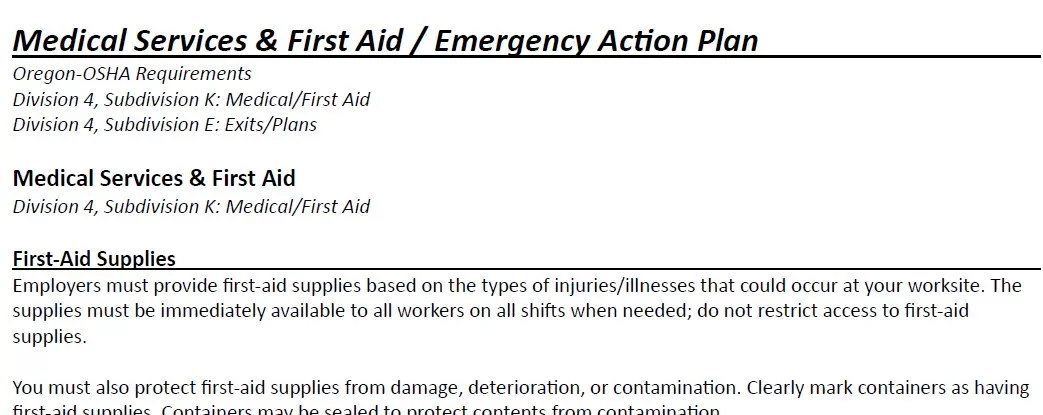
Printable Medical Services & First Aid/Emergency Action Plan Summary
A printable PDF summary of OR-OSHA’s medical services and first aid/emergency action plan rules.
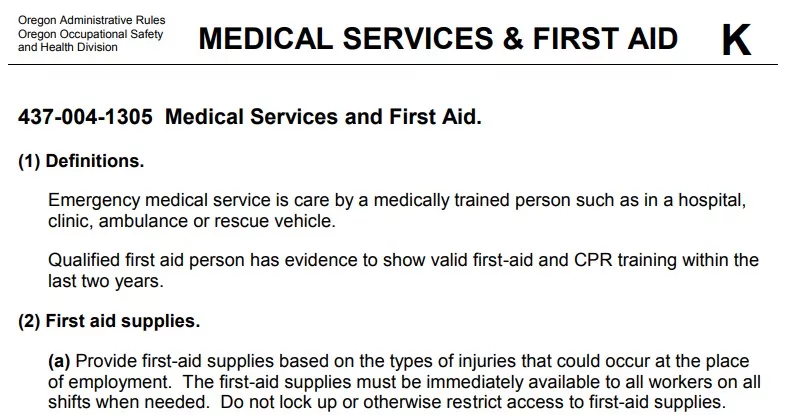
OR-OSHA Division 4 Rule Text: Medical & First Aid
Read OR-OSHA’s Division 4 rules about medical services and first aid requirements.
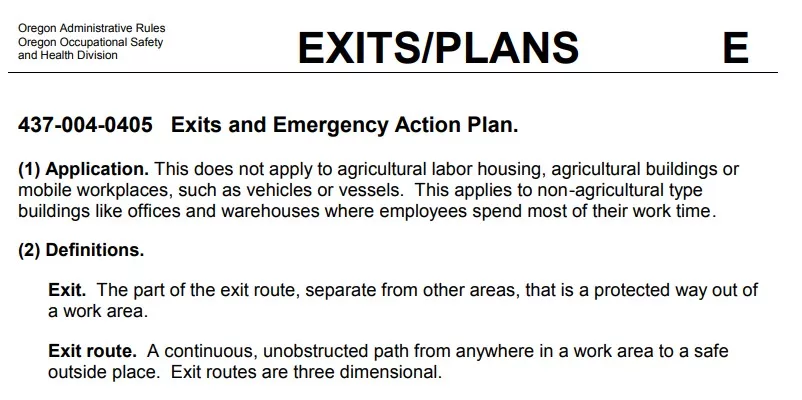
OR-OSHA Division 4 Rule Text: Exits/Plans
Read OR-OSHA’s Division 4 rules about emergency action plan requirements.
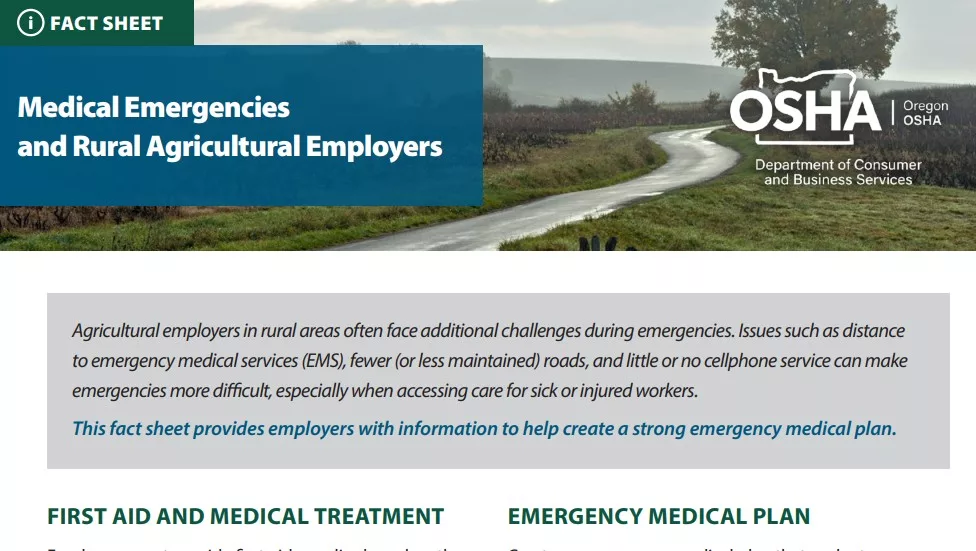
Medical Emergencies & Rural Agricultural Employers Fact Sheet - English
Read OR-OSHA’s fact sheet about first aid, medical treatment, and emergency medical plan requirements for rural agricultural employers – English version.
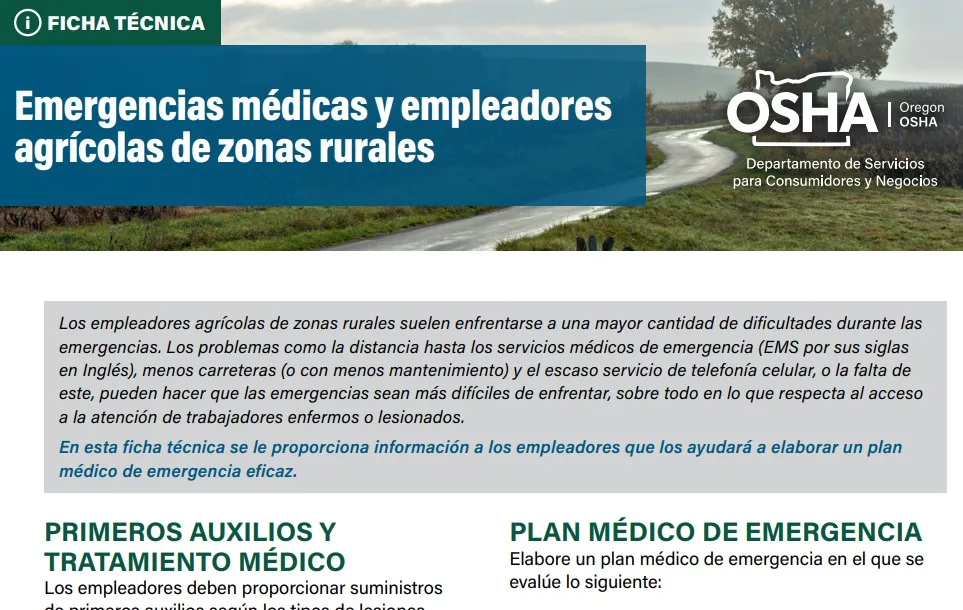
Medical Emergencies & Rural Agricultural Employers Fact Sheet - Spanish
Read OR-OSHA’s fact sheet about first aid, medical treatment, and emergency medical plan requirements for rural agricultural employers – Spanish version.
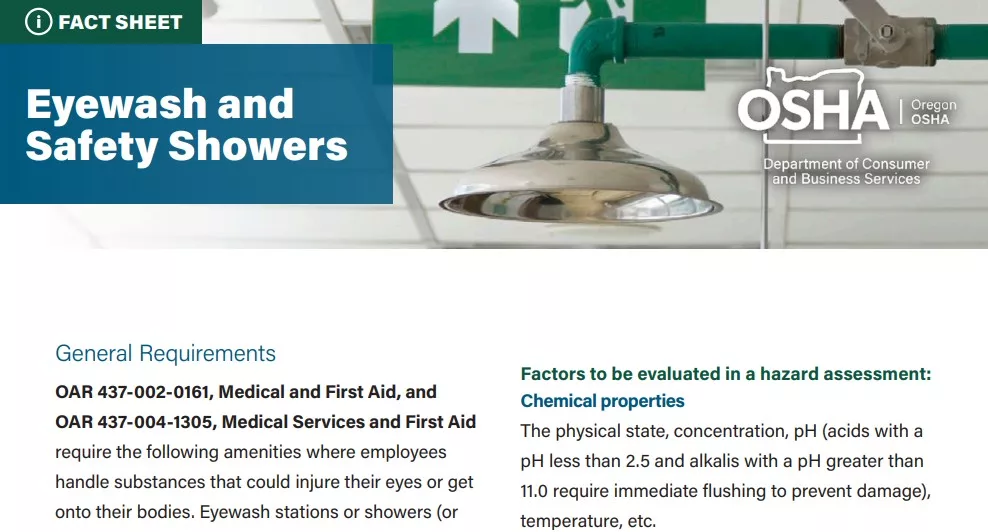
Eyewash and Safety Showers Fact Sheet
Read OR-OSHA’s fact sheet about eye wash and safety shower requirements.
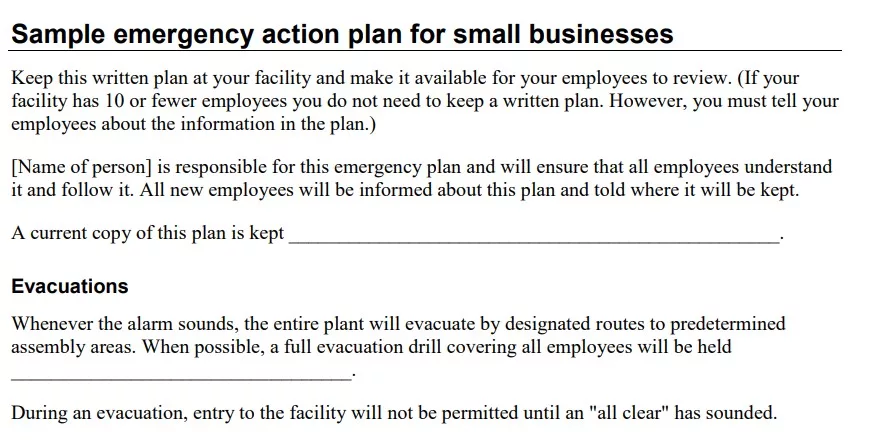
Template for Emergency Action Plan for Small Businesses
A sample Emergency Action plan for small businesses.
